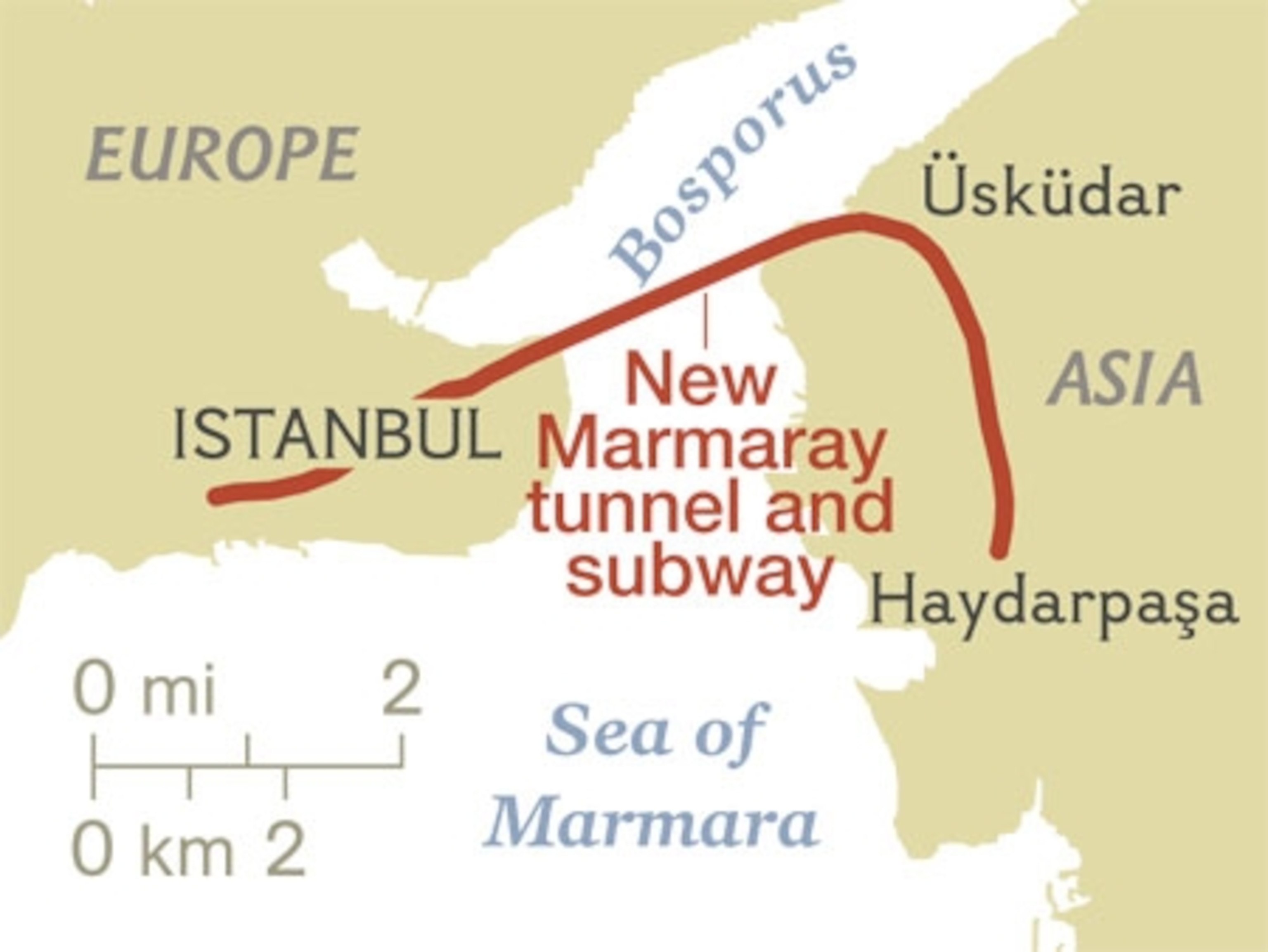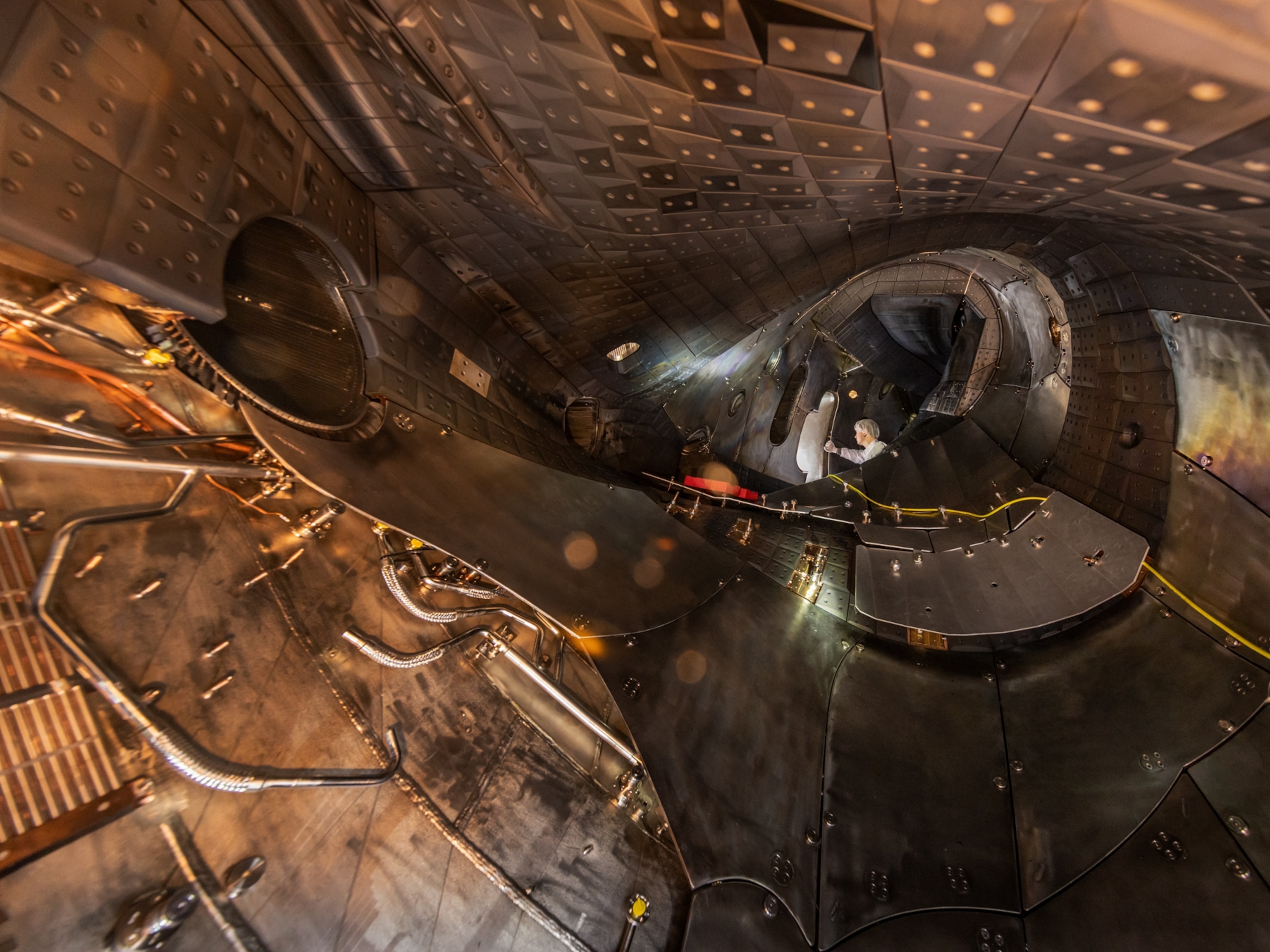
Turkey’s New Undersea Tunnel Is Built to Resist Earthquakes
How engineers made a train tunnel that connects two continents
Istanbul has tunnel vision. A new undersea tunnel now connects the city's Asian and European sides and faced a major engineering challenge: withstanding the area's potentially devastating earthquakes.
October 29 marked the 90th anniversary of the formation of the Turkish Republic, and residents of Istanbul had an extra reason to celebrate. The date marked the opening of the first phase of the Marmaray project, a large regional rail effort that includes an undersea tunnel that now allows commuters to take a train across the Bosphorus Strait and skip Istanbul's notoriously congested roadways.
The newly opened section extends underground for 8.5 miles (13.6 kilometers), with 0.8 miles (1.4 kilometers) buried under the seabed, nearly 200 feet (56 meters) under the water of the strait.

When designing the tunnel, engineers had to take into account its proximity to the active North Anatolian Fault, which lies about 10 miles (16 kilometers) away. Activity along this 930-mile (1,500-kilometer) fault system resulted in a devastating 7.4 magnitude earthquake that struck Turkey in 1999, killing tens of thousands of people.
"The earthquake hazard really drove the design of the project," said Joseph Wartman, a civil engineering professor at the University of Washington in Seattle who was not involved with the project but has studied its progress due to his work on earthquake-resistant design. The tunnel's engineers had to account for the possibility of earthquakes of magnitudes as large as 7.5, he said. "It's about as challenging as it gets for tunnel design."
Earthquake safety determined the sizing of the tunnel and a lot of the design details, Wartman said. "This project really posed some significant challenges to the designers. It's really pushing the boundaries of underground construction in a seismically active area."
Although earthquakes can cause a lot of shaking, that's not as much of a concern with underground tunnels, Wartman said. "They're actually some of the safest places to be, because the level of shaking is lower below the ground compared to the surface." He explained that this is due to the mechanics by which the seismic waves propagate across the ground.
"It may not be particularly intuitive that something deep is actually safer, but that's the case in this situation," he said.
Turning Solid Ground Into Liquid
The real concern during an earthquake is a phenomenon known as liquefaction, which can temporarily soften the soil surrounding the tunnel, effectively turning that soil into a liquid, Wartman said. "The soil is no longer supporting the tunnel, it's trying to dislodge it, and it can actually cause tunnels to float up," he said.
"We have seen many cases where below-ground structures such as gasoline tanks float up to the surface in an earthquake."
Jonathan Stewart, a civil engineering professor at the University of California, Los Angeles also pointed to liquefaction as a major concern for the Marmaray project, especially given the massive liquefaction observed during the 1999 earthquake in Turkey. "That's probably the single biggest threat," said Stewart, who was not involved with the tunnel's design.
Stewart noted that the North Anatolian Fault is similar to the San Andreas Fault in California and said similar concerns had to be addressed when building the Bay Area Rapid Transit (BART) tunnel under the San Francisco Bay.
But despite similarities with California, the tunnel in Turkey was far more complicated, said Wartman. "What's unique about this project is that it has an extreme liquefaction hazard, much higher than, for example, the tube that runs for the BART system under the San Francisco Bay." That's a result of the type of soil present and the severity of the earthquakes that hit the region, he said.
To prevent liquefaction, engineers had to make the soil around the tunnel more dense, Wartman said. They did this by drilling holes into the soil adjacent to the tunnel and injecting grout under high pressure. "Grout is just concrete without the sand, like a slurry, and as it enters the soil it will make it denser," he said, explaining that close to 3,000 grout columns were injected around the tunnel.
"It had seemed like an almost insurmountable problem, but I think this is a pretty effective mitigation measure," he said.
All About Flexibility
Long underwater tunnels are usually built in preconstructed segments that are then connected with joints, said UCLA's Stewart. The joints need to have enough flexibility that they won't rupture during an earthquake, he said.
"If you build the tube as a continuous piece, the deformation can be too large for the structure to accommodate, and you can end up with fractures that result in leakage," said Jack Moehle, an engineering professor at the University of California, Berkeley, who has spent several years working on the underwater BART tunnel. "So you build it in segments, and you make sure that each segment is connected by a flexible joint, so that the deformations can be accommodated."
The Marmaray tunnel was constructed from 11 sections that were connected with joints.
Underwater construction faces other hazards from earthquakes, Moehle said. "If the ground is shaking, that can unleash an underwater landslide," he said, adding that how much of a concern that is depends on the local geology.
Unforeseen Details and Surface Worries
The Marmaray tunnel engineers had taken a lot of care to account for earthquake-related issues in their design, said Wartman. "Based on what we've seen in past earthquakes, I would think it's a quite safe design," he said.
But Wartman cautioned that any large project could always have complications. "That would probably be the biggest concern here, that there are unforeseen details providing some trouble," he said.
"We as engineers try to think through all of these worst-case scenarios, but there's probably a countless variety of these details that go into every large project."
The real concern may not be with the underwater tunnel itself, but instead with the above-ground city, said UCLA's Stewart. Although the 1999 earthquake was devastating, the brunt of it was borne by areas farther away from Istanbul, he said. "Because of the fact that the fault just south of Istanbul did not rupture then, it's probably under a considerable amount of stress now, and Istanbul is one of the more at-risk cities in the world for earthquakes," Stewart said.
"We know that the fault is primed and ready to go, and there's a lot of very vulnerable buildings there," he said. "There's a potential for a real catastrophe," and if an actual earthquake happens, the tunnel could well be one of the safest places in the city, he said.








